

Latest Trends in Performance Management, Career Progression, and L&D. Key Findings Your Engagement Is Strong, but What About Your Alignment?
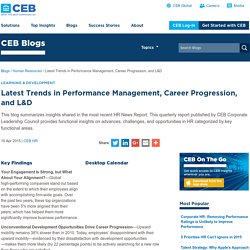
—Global high-performing companies stand out based on the extent to which their employees align with accomplishing firm-wide goals. Over the past two years, these top organizations have been 5% more aligned than their peers, which has helped them more significantly improve business performance. Unconventional Development Opportunities Drive Career Progression—Upward mobility remains 38% slower than in 2010. Today, employees’ disappointment with their upward mobility—evidenced by their dissatisfaction with development opportunities—makes them more likely (by 22 percentage points) to be actively searching for a new role than those who are satisfied. Latest Trends in Performance Management, Career Progression, and L&D. Performance management is broken: Replace “rank and yank” with coaching and development. Today’s widespread ranking- and ratings-based performance management is damaging employee engagement, alienating high performers, and costing managers valuable time.Only 8 percent of companies report that their performance management process drives high levels of value, while 58 percent said it is not an effective use of time.Leading organizations are scrapping the annual evaluation cycle and replacing it with ongoing feedback and coaching designed to promote continuous employee development.
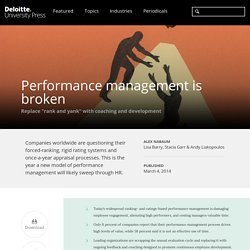
Traditional performance management —the annual process of rating employees’ performance and ranking them against their colleagues—is widely considered to be broken. These “forced curve” evaluations became popular under the influence of the GE model during Jack Welch’s tenure, but they were originally conceived around the turn of that century—the turn of the 19th to the 20th century, that is. Today, more than 70 percent of all employees work in service or knowledge-related jobs. Bottom line. How New Performance Management Trends will Make a Big Impact - Engage for SuccessEngage for Success. Performance management is the talk of the business world right now with top companies overhauling their strategies in line with new trends.
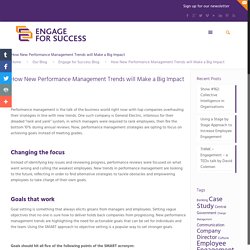
One such company is General Electric, infamous for their dreaded “rank and yank” system, in which managers were required to rank employees, then fire the bottom 10% during annual reviews. Now, performance management strategies are opting to focus on achieving goals instead of meeting grades. Changing the focus Instead of identifying key issues and reviewing progress, performance reviews were focused on what went wrong and culling the weakest employees.
New trends in performance management are looking to the future, reflecting in order to find alternative strategies to tackle obstacles and empowering employees to take charge of their own goals. Goals that work Goal setting is something that always elicits groans from managers and employees. Goals should hit all five of the following points of the SMART acronym: Simplifying the system An ongoing process. Performance Management Software System. 5 Performance Management Trends that are Shaking Up HR. Stuart Hearn – Author and performance management specialist This is a guest post from Stuart Hearn, who holds views very similar to mine on performance management.
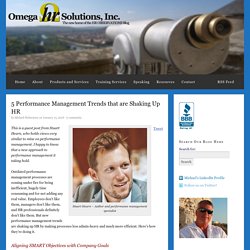
I happy to know that a new approach to performance management it taking hold. Outdated performance management processes are coming under fire for being inefficient, hugely time consuming and for not adding any real value. Employees don’t like them, managers don’t like them, and HR professionals definitely don’t like them. But new performance management trends are shaking up HR by making processes less admin-heavy and much more efficient.
Aligning SMART Objectives with Company Goals Anyone working in performance related HR will be familiar with the concept of SMART objectives — an acronym used to set goals that are specific, measurable, achievable, relevant and time-bound. Regular Check-In Meetings In-the-Moment Feedback De-Coupling Reward Simplification through Software Sign up for free HR Solutions updates via email. 5 Performance Management Trends for 2015 - OKRs and Continuous Performance Management. Are you ready to transform your workplace in 2015?
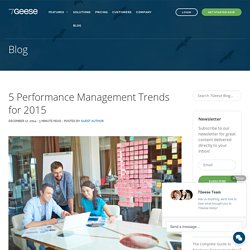
Or are you doomed to repeat the same performance management process that failed to deliver value to your employees and your organization? Revamping your performance management can be frightening for some. Especially if you’ve always relied solely on annual performance reviews (which we know don’t work). Yet, performance management isn’t the same thing as a performance review. So unless you’ve already included coaching, feedback, motivation, engagement, and improvement in your process, you’ve failed. The good news though is that there is still time to change. Here are a few trends we see for 2015 and beyond: 1. Performance management is no longer the responsibility of a manager. 2. No one wants to be ranked. Redesigning performance management - key trends of 2015. Back in April, my interest was piqued by an article in the Harvard Business Review.

It focused on Deloitte’s new performance management strategy, specifically the research and thinking behind the innovations. But it wasn’t the first clue we’ve had that performance management (PM) is changing. Intel’s OKR (objective and key results) strategy has been sweeping through technology companies for years. More recently, we’ve seen Adobe, Juniper and Microsoft drop annual performance reviews and forced rankings. Redesigning performance management - key trends of 2015.